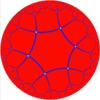User:Tomruen/Snub (geometry)
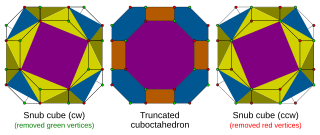
See that red and green dots are placed at alternate vertices. A snub cube is generated from deleting either set of vertices, one resulting in clockwise gyrated squares, and other counterclockwise.
In geometry, a snub is an operation on a regular or quasi-regular polyhedron or tiling that defines a related polyhedron or tiling with the same faces with new triangle faces. The term originates from two semiregular polyhedron, named by Kepler named as snub cube (cubus simum) and snub dodecahedron (dodekaeder simum). Snubs contain chiral symmetry that arises from an alternation operation.
History[edit]
In Wythoff constructions there are two competing definitions that are consistent for polyhedra, but diverge on higher polytopes. The first definition follows Kepler's naming from the regular forms. In this construction the snub cube and snub octahedron are two names for the same polyhedron, containing the 6 faces of the cube, the 8 faces of the octahedron, and two triangles in place of each of the 12 edges of either regular polyhedron.
Coxeter recognized both regular polyhedra as generators and wrote the snub cube as a vertical Schläfli symbol and Coxeter diagram ![]()
![]()
![]() . He gave the cuboctahedron the symbol , Coxeter diagram
. He gave the cuboctahedron the symbol , Coxeter diagram ![]()
![]()
![]() , and truncated cuboctahedron as , Coxeter diagram
, and truncated cuboctahedron as , Coxeter diagram ![]()
![]()
![]() . The rhombitruncated cuboctahedron he represented by , Coxeter diagram
. The rhombitruncated cuboctahedron he represented by , Coxeter diagram ![]()
![]()
![]() . From these constructions is is apparent that a snub is an alternation of a truncated quasiregular polyhedron. So he considered the snub cube more constructionally explicitly named from the quasiregular polyhedron, the cuboctahedron as a snub cuboctahedron.
. From these constructions is is apparent that a snub is an alternation of a truncated quasiregular polyhedron. So he considered the snub cube more constructionally explicitly named from the quasiregular polyhedron, the cuboctahedron as a snub cuboctahedron.
This naming aided Coxeter in naming the only uniform snub in 4D, the snub 24-cell, ![]()
![]()
![]()
![]()
![]()
![]()
![]() , as an alternated truncated 24-cell, with the 24-cell
, as an alternated truncated 24-cell, with the 24-cell ![]()
![]()
![]()
![]()
![]()
![]()
![]() and truncated 24-cell
and truncated 24-cell ![]()
![]()
![]()
![]()
![]()
![]()
![]() .
.
From this interpretation the snub octahedron is not identical to the snub cube (snub cuboctahedron), but construcated as an alternated truncated octahedron, ![]()
![]()
![]()
![]()
![]() , which is a lower symmetry form of the icosahedron. In addition a snub tetratetrahedron is another name with the tetratetrahedron as a bicolored octahedron, which can be truncated, and then alternated also into an icosahedron.
, which is a lower symmetry form of the icosahedron. In addition a snub tetratetrahedron is another name with the tetratetrahedron as a bicolored octahedron, which can be truncated, and then alternated also into an icosahedron.
Constructions[edit]
The snubs can be seen as created in two topological constructive steps.
First truncated creating the truncated cuboctahedron, and lastly alternated into the snub cube. You can see from the picture on the right that there are two ways to alternate the vertices, and they are mirror images of each other, creating two chiral forms. Finally all edges would be rescaled to unity. - Note: this latter part depends on the degree of freedom.
The Coxeter-Dynkin diagrams are given showing the active mirrors in the Wythoff construction. The truncated quasiregular form is also called an omnitruncation with all of the mirrors active (ringed). The alternation is shown as rings with holes.
The original regular form faces are show in red. The regular dual faces are in yellow. The quasiregular polyhedron has all the red and yellow faces combined. The truncated quasiregular form has new square faces in blue. In the snub, the blue squares are reduced to edges, and new blue triangles are shown in the alternated vertex gaps.
Snub polyhedron[edit]
| Symmetry (p q 2) |
Regular |
Dual regular |
Quasiregular |
Truncated quasiregular |
Snub |
|---|---|---|---|---|---|
| Tetrahedral (3 3 2) |
 Tetrahedron |
 Tetrahedron |
 Tetratetrahedron |
 Truncated tetratetrahedron |
 Icosahedron (Snub tetratetrahedron) |
| Octahedral (4 3 2) |
 Cube |
 Octahedron |
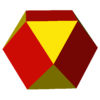 Cuboctahedron |
 Truncated cuboctahedron |
 Snub cube (Snub cuboctahedron) |
| Icosahedral (5 3 2) |
 Dodecahedron |
 Icosahedron |
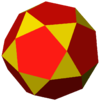 Icosidodecahedron |
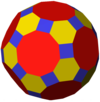 Truncated icosidodecahedron |
 Snub dodecahedron (Snub icosidodecahedron) |
Snub Euclidean tilings[edit]
| Symmetry (p q 2) |
Regular |
Dual regular |
Quasiregular |
Truncated quasiregular |
Snub |
|---|---|---|---|---|---|
| Square (4 4 2) |
 Square tiling |
 Square tiling |
 Square tiling |
 Truncated square tiling |
 Snub square tiling |
| Hexagonal (6 3 2) |
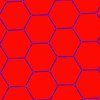 Hexagonal tiling |
 Triangular tiling |
 Trihexagonal tiling |
 Truncated trihexagonal tiling |
 Snub trihexagonal tiling |
Snub hyperbolic tilings[edit]
References[edit]
- Coxeter, H.S.M. Regular Polytopes, (3rd edition, 1973), Dover edition, ISBN 0-486-61480-8 (pp. 154–156 8.6 Partial truncation, or alternation)
- Norman Johnson Uniform Polytopes, Manuscript (1991)
- N.W. Johnson: The Theory of Uniform Polytopes and Honeycombs, Ph.D. Dissertation, University of Toronto, 1966
- Weisstein, Eric W. "Snubification". MathWorld.
- Richard Klitzing, Snubs, alternated facetings, and Stott-Coxeter-Dynkin diagrams, Symmetry: Culture and Science, Vol. 21, No.4, 329-344, (2010) [1]















